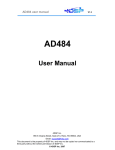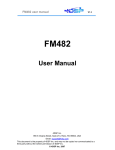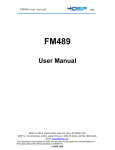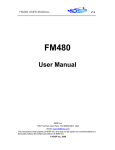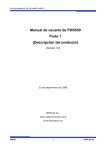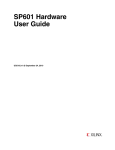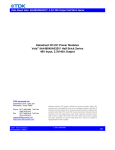Download User Manual - Hybrid DSP
Transcript
AD490 user manual V1.0 AD490 User Manual 4DSP Inc. 955 S Virginia Street, Suite 214, Reno, NV 89502, USA Email: [email protected] This document is the property of 4DSP Inc. and may not be copied nor communicated to a third party without the written permission of 4DSP Inc. © 4DSP Inc. 2007 AD490 user manual V1.0 Revision History Date 02-09-07 February 2007 Revision First release Version 1.0 AD490 User manual www.4dsp.com -2- AD490 user manual V1.0 Table of Contents 1 2 3 4 5 6 7 8 9 Acronyms and related documents ............................................................................. 4 1.1 Acronyms............................................................................................................... 4 1.2 Related Documents ............................................................................................... 4 1.3 General description................................................................................................ 5 Installation ................................................................................................................... 6 2.1 Requirements and handling instructions ................................................................ 6 2.2 Firmware and software........................................................................................... 6 Design .......................................................................................................................... 6 3.1 FPGA devices ........................................................................................................ 6 3.1.1 Virtex-4 device A ............................................................................................ 6 3.1.2 Virtex-4 device B ............................................................................................ 9 3.2 FPGA devices configuration..................................................................................10 3.2.1 Flash storage ................................................................................................10 3.2.2 CPLD device .................................................................................................10 3.2.3 JTAG.............................................................................................................12 3.3 Clock tree..............................................................................................................13 3.4 Memory resources ................................................................................................13 3.4.1 QDR2 SRAM.................................................................................................13 3.4.2 DDR2 SDRAM ..............................................................................................13 3.5 A/D inputs and outputs main characteristics..........................................................14 3.6 Front Panel optical transceivers ............................................................................15 Power requirements ...................................................................................................16 4.1 External power connector for stand alone mode ...................................................17 System Side view........................................................................................................18 Environment................................................................................................................18 6.1 Temperature .........................................................................................................18 6.2 Convection cooling................................................................................................18 6.3 Conduction cooling ...............................................................................................18 Safety...........................................................................................................................18 EMC .............................................................................................................................19 Warranty......................................................................................................................19 February 2007 AD490 User manual www.4dsp.com -3- AD490 user manual V1.0 1 Acronyms and related documents 1.1 Acronyms ADC DAC DCI DDR DSP EPROM FBGA FPDP FPGA JTAG LED LVTTL LVDS LSB LVDS MGT MSB PCB PCI PCI-e PLL PMC QDR SDRAM SRAM Analog to Digital Converter Digital to Analog Converter Digitally Controlled Impedance Double Data Rate Digital Signal Processing Erasable Programmable Read-Only Memory Fineline Ball Grid Array Front Panel Data Port Field Programmable Gate Array Join Test Action Group Light Emitting Diode Low Voltage Transistor Logic level Low Differential Data Signaling Least Significant Bit(s) Low Voltage Differential Signaling Multi-Gigabit Transceiver Most Significant Bit(s) Printed Circuit Board Peripheral Component Interconnect PCI Express Phase Locked Loop PCI Mezzanine Card Quadruple Data rate Synchronous Dynamic Random Access memory Synchronous Random Access memory Table 1: Glossary 1.2 Related Documents IEEE Std 1386.1-2001 : IEEE Standard Physical and Environmental Layers for PCI Mezzanine Cards (PMC). ANSI/VITA 32-2003 : Processor PMC. ANSI/VITA 39-2003 : PCI-X for PMC and Processor PMC. ANSI/VITA 42.0-2005 : XMC Switched Mezzanine Card Auxiliary Standard. IEEE Std 1386-2001 : IEEE Standard for a Common Mezzanine Card (CMC) Family. Xilinx Virtex-4 user guide Xilinx PCI-X core datasheet Xilinx Virtex-4 Rocket I/O guide February 2007 AD490 User manual www.4dsp.com -4- AD490 user manual 1.3 V1.0 General description The AD490 is a high performance PMC/XMC digitizer module dedicated to digital signal processing applications with high bandwidth and complex algorithms requirements. The AD490 can interface to a PCI-express, PCI-X and/or PCI bus. In addition to two 210MSPS A/D channels, the AD490 offers fast on-board memory resources and two Virtex-4 FPGAs. Up to 4x 2.5Gbps optical transceivers for serial FPDP or gigabit Ethernet applications are available for communication with external systems. The AD490 is mechanically and electrically compliant to the standard and specifications listed in section 1.2 of this document. Figure 1: AD490 block diagram The AD490 converts 2 analogue signals into two 12-bit resolution digital data flows. Analogue to digital conversion is performed by two Analog Devices AD9430 up to 210 MSPS per channel. The clock source can be set to external or internal using the software and firmware settings available to users. Please note that the clock generation is using low-jitter clock synthesizers. February 2007 AD490 User manual www.4dsp.com -5- AD490 user manual V1.0 2 Installation 2.1 Requirements and handling instructions The AD490 must be installed on a motherboard compliant to the IEEE Std 1386-2001 standard for 3.3V PMC or on a motherboard compliant to the XMC Switched Mezzanine Card Auxiliary Standard Do not flex the board Observe SSD precautions when handling the board to prevent electrostatic discharges. Do not install the AD490 while the motherboard is powered up. 2.2 Firmware and software Drivers, API libraries and a program example working in combination with a pre-programmed firmware for both FPGAs are provided. The AD490 is delivered with an interface to the Xilinx PCI core in the Virtex-4 device A and an example VHDL design in the Virtex-4 device B so users can start digitizing and performing data manipulation right out of the box. For more information about software installation and FPGA firmware, please refer the AD490 Get Started Guide and to the Programmer’s guide available online. 3 Design 3.1 FPGA devices The Virtex-4 FPGA devices interface to the various resources on the AD490 as shown on Figure 1. They also interconnect to each other via 86 general purpose pins and 2 clock pins. 3.1.1 3.1.1.1 Virtex-4 device A Virtex-4 device A family and package The Virtex-4 device A is from the Virtex-4 FX family. It can be either an XC4VFX20 or XC4VFX60 in a Fineline Ball Grid array with 672 balls (FF672). 3.1.1.2 Power PC embedded processor Up to two IBM PowerPC RISC processor cores are available in the Virtex-4 device A. This core can be used to execute C based algorithms and control the logic resources implemented in the FPGA. 3.1.1.3 Virtex-4 device A external memory interfaces The Virtex-4 device A is connected to a 128Mbytes SDRAM bank with a 32-bit data bus width. This memory resource can be used by the PowerPC core or can serve as data buffer. February 2007 AD490 User manual www.4dsp.com -6- AD490 user manual 3.1.1.4 V1.0 PCI interface The Virtex-4 device A interfaces directly to the PCI bus via the PMC Pn1, Pn2 and Pn3 connectors or to the PCI-e bus via the Pn5. An embedded PCI core from Xilinx is used to communicate over the PCI bus with the host system on the motherboard. PCI-e 4 lanes, PCIX 64-bit 66MHz/133MHz, PCI 64-bit 66MHz and PCI 32-bit 33MHz are supported on the AD490. The bus type must be communicated at the time of the order so the right Virtex-4 device A firmware can be loaded into the flash prior to delivery. The following performances have been recorded with the AD490 transferring data on the bus: PCI-X 64-bit 133MHz: 750Mbytes/s sustained PCI-X 64-bit 66MHz: 425Mbytes/s sustained PCI 32-bit 33MHz: 112Mbytes/s sustained Without any data reduction it is therefore possible to transfer over a PCI-X bus two digitized signals with a 12-bit resolution each. The resulting bandwidth would be 630Mbytes/s. The PCI-express 4-lane is using the MGT I/Os on the Virtex-4 device A. Power filtering, low jitter clock and special routing are used to achieve the performances required by this standard. Please refer to the Front Panel Optical transceivers section of this document for more details (3.6). 3.1.1.5 LED Four LEDs are connected to the Virtex-4 device A. In the default FPGA firmware, the LEDs are driven by the Virtex-4 device B via the Virtex-4 device A/ Virtex-4 device B interface. The LEDs are located on side 2 of the PCB in the front panel area. Figure 2: FPGA LED locations February 2007 AD490 User manual www.4dsp.com -7- AD490 user manual 3.1.1.6 V1.0 Pn4 user I/O connector The Pn4 connector is wired to the Virtex-4 device A. The 32 lower bits are available only if an XC4VFX60 device is mounted on board. The 32 higher bits are available only if PCI 32-bit is used and only if specified at the time of order. All signals are user-defined 3.3V LVTLL./LVCMOS. Connector pin 1 3 5 7 9 11 13 15 17 19 21 23 25 27 29 31 33 35 37 39 41 43 45 47 49 51 53 55 57 59 61 63 Signal name Pn4_IO0 Pn4_IO2 Pn4_IO4 Pn4_IO6 Pn4_IO8 Pn4_IO10 Pn4_IO12 Pn4_IO14 Pn4_IO16 Pn4_IO18 Pn4_IO20 Pn4_IO22 Pn4_IO24 Pn4_IO26 Pn4_IO28 Pn4_IO30 Pn4_IO32 Pn4_IO34 Pn4_IO36 Pn4_IO38 Pn4_IO40 Pn4_IO42 Pn4_IO44 Pn4_IO46 Pn4_IO48 Pn4_IO50 Pn4_IO52 Pn4_IO54 Pn4_IO56 Pn4_IO58 Pn4_IO60 Pn4_IO62 FPGA pin M9 N11 N7 N6 P10 P9 R8 R6 N21 M20 P19 N18 P16 R18 P21 R17 L9 L5 AD10 L3 AC11 N4 T8 R5 AB10 R3 Y10 P3 U5 T3 V6 V4 FPGA pin M10 M11 N8 P6 P11 N9 P8 R7 M21 M19 N19 N17 N16 P18 P20 R16 M5 AD11 L4 AB11 M4 T9 P5 AA10 P4 W10 N3 U6 T4 U7 U4 U9 Signal name Pn4_IO1 Pn4_IO3 Pn4_IO5 Pn4_IO7 Pn4_IO9 Pn4_IO11 Pn4_IO13 Pn4_IO15 Pn4_IO17 Pn4_IO19 Pn4_IO21 Pn4_IO23 Pn4_IO25 Pn4_IO27 Pn4_IO29 Pn4_IO31 Pn4_IO33 Pn4_IO35 Pn4_IO37 Pn4_IO39 Pn4_IO41 Pn4_IO43 Pn4_IO45 Pn4_IO47 Pn4_IO49 Pn4_IO51 Pn4_IO53 Pn4_IO55 Pn4_IO57 Pn4_IO59 Pn4_IO61 Pn4_IO63 Connector pin 2 4 6 8 10 12 14 16 18 20 22 24 26 28 30 32 34 36 38 40 42 44 46 48 50 52 54 56 58 60 62 64 Table 2 : Pn4 pin assignment February 2007 AD490 User manual www.4dsp.com -8- AD490 user manual 3.1.2 3.1.2.1 V1.0 Virtex-4 device B Virtex-4 device B family and package The Virtex-4 device B is dedicated to interfacing to the A/D circuitry and can also perform Digital Signal Processing algorithms. It is available in the Virtex-4 SX or LX family devices and is packaged in a 1148-ball Fineline Ball Grid array. In terms of logic and dedicated DSP resources, The FPGA B can be chosen in 5 different sizes: SX55, LX40, LX60, LX80, LX100 and LX160. 3.1.2.2 Virtex-4 device B external memory interfaces The Virtex-4 device B interfaces to four 8Mbytes QDR2 SRAM devices with 32-bit data bus, Please note that the four QDR2 SRAM devices are only available with the LX80, LX100 and LX160 devices. For smaller Virtex-4 FPGAs (LX40, LX60 and SX55) only three QDR2 SRAM devices are connected to the FPGA. February 2007 AD490 User manual www.4dsp.com -9- AD490 user manual 3.2 V1.0 FPGA devices configuration 3.2.1 Flash storage The FPGA firmware is stored on board in a flash device. The 128Mbit device is partly used to store the configuration for both FPGAs. In the default CPLD firmware configuration, the Virtex-4 devices A and B are directly configured from flash if a valid bitstream is stored in the flash for each FPGA. The flash is pre-programmed in factory with the default firmware example for both FPGAs. Figure 3 : Configuration circuit 3.2.2 CPLD device As shown on Figure 2, a CPLD is present on board to interface between the flash device and the FPGA devices. It is of type CoolRunner-II. The CPLD is used to program and read the flash. The data stored in the flash are transferred from the host motherboard via the PCI bus to the Virtex-4 device A and then to the CPLD that writes the required bit stream to the storage device. A 31.25 MHz clock connects to the CPLD and is used to generate the configuration clock sent to the FPGA devices. At power up, if the CPLD detects that an FPGA configuration bitstream is stored in the flash for both FPGA devices, it will start reading programming the devices in SelecMap mode. Do NOT reprogram the CPLD without 4DSP approval The CPLD configuration is achieved by loading with a Xilinx download cable a bitstream from a host computer via the JTAG connector. The FPGA devices configuration can also be performed using the JTAG. 3.2.2.1 DIP Switch A switch (J1) is located next to the JTAG programming connector (J6) see Figure 4. The switch positions are defined as follows: February 2007 AD490 User manual www.4dsp.com - 10 - AD490 user manual V1.0 Figure 4: switch (J1) location Sw1 OFF Default setting. The Virtex-4 device A configuration is loaded from the flash at power up. ON Virtex-4 device A safety configuration loaded from the flash at power up. To be used only if the Virtex-4 device A cannot be configured or does not perform properly with the switch in the OFF position. Sw2 Reserved Sw3 Reserved Sw4 Reserved Table 3: Switch description 3.2.2.2 LED and board status Four LEDs connect to the CPLD and give information about the board status. LED 0 LED 1 LED 2 LED 3 LED 3 Flashing FPGA A or B bitstream or user_ROM_register is currently being written to the flash ON FPGA A not configured OFF FPGA A configured Flashing FPGA A or B bitstream or user_ROM_register is currently being written to the flash ON FPGA B not configured OFF FPGA B configured Flashing The Virtex-4 device A has been configured with the safety configuration bitstream programmed in the flash at factory. Please write a valid Virtex-4 device A bitstream to the flash. ON Flash is busy writing or erasing OFF Flash device is not busy ON CRC error. Presumably a wrong or corrupted FPGA bitstream has been written to the flash. Once on this LED remains on OFF No CRC error detected Table 4: LED board status February 2007 AD490 User manual www.4dsp.com - 11 - AD490 user manual V1.0 Figure 5: CPLD LED locations 3.2.3 JTAG A JTAG connector is available on the AD490 for configuration purposes. The JTAG can also be used to debug the FPGA design with the Xilinx Chipscope. The JTAG connector is located on side 1 of the PCB in front (see Figure 6). YFF WPV JQG WGL WFN WGR -7$*FRQQHFWRU Figure 6: JTAG connector (J6) location The JTAG connector pinout is as follows: Pin # 1 2 3 Signal 1.8V GND TCK Signal TMS TDI TDO Pin # 4 5 6 Table 5 : JTAG pin assignment February 2007 AD490 User manual www.4dsp.com - 12 - AD490 user manual 3.3 V1.0 Clock tree The AD490 clock architecture offers an efficient distribution of low jitter clocks. In addition to the PCI Express bus, the MGT reference clocks of 106.25MHz and 125MHz (Epson EG2121CA) make it possible to implement several standards over the MGT I/Os connected to the optical transceivers. Both FPGAs receive a low jitter 125MHz clock. A low jitter programmable clock able to generate frequencies from 62.5MHz to 255.5MHz in steps of 0.5MHz is also available. This clock management approach ensures maximum flexibility to efficiently implement multi-clock domains algorithms and use the memory devices at different frequencies. Both clock buffer devices (CDM1804) and the frequency synthesizer (ICS8430-61) are controlled by the Virtex-4 device A. Figure 7 : Clock tree 3.4 Memory resources 3.4.1 QDR2 SRAM Four independent QDR2 SRAM devices are connected to the Virtex-4 device B. The QDR2 SRAM devices available on the AD490 are 2M words deep (8Mbytes per memory device). Please note that only three QDR SRAM devices are available to the user if the XC4VLX40, XC4VLX60 or XC4VSX55 FPGA device is mounted on board. 3.4.2 DDR2 SDRAM Two 16-bit DDR2 SDRAM devices of 128MBytes each are connected to Virtex-4 device A. The two memories share the same address and control bus and have their own data bus. This memory resource can be accessed by the PowerPC processor in the Virtex-4 device A or can be used as a data buffer for custom user logic. February 2007 AD490 User manual www.4dsp.com - 13 - AD490 user manual 3.5 V1.0 A/D inputs and outputs main characteristics Analogue inputs Input voltage range Maximum input voltage 1.536 Volts p-p – Full scale (0.768 Volts p-p – Half Scale). AC coupled. MMCX. (Scale selection via control register). Maximum absolute rating: +/- 8Volts 8Vp-p. Values > 8Vp-p might damage the board. Impedance 50Ù - terminated to ground – single ended Bandwidth ADC bandwidth: 700 MHz. Input RF transformer: 800MHz. External sampling clock inputs Format Frequency range Single ended (or differential 3.3V PECL optional) – AC coupled. MMCX Maximum absolute rating: +/- 5Volts 40-210 MHz External Trigger inputs Format Input Voltage range Frequency range Single ended (or differential 3.3V PECL optional) – DC coupled. MMCX Maximum absolute rating: +/- 5Volts 1.4 Volts peak-to-peak minimum 105 MHz maximum ADC Output Output Data Width Data Format 12-Bits 2’s Compliment or offset binary (Changeable via control register) SFDR Up to 68dB (80dB is the maximum provided by Analogue Devices) SNR Up to 56dB (65dB is the maximum provided by Analogue Devices) Maximum Sampling Frequency 210 MHz. FPGA Input bandwidth from ADC Digital Signal Processing Bus interface Bus bandwidth 2-channel, 210MSPS per channel Many arithmetic and logic resources are available to the user inside the Virtex-II Pro, Virtex-4 or Virtex-5 device on the PMC or TIM for real time processing PCI 32/64-bit 33/66MHz , PCI-X 32/64-bit 64/133MHz PCIe. In excess of 80% of PCI bus theoretical bandwidth. (Speed may vary depending on the host computer performances) Example: PCI 32-bit 33MHz = 112MBytes/s continuous, PCI-X 64-bit 66MHz = 425MBytes/s continuous Table 6: AD490 A/D characteristics February 2007 AD490 User manual www.4dsp.com - 14 - AD490 user manual 3.6 V1.0 Front Panel optical transceivers Four 2.5Gb/s optical transceivers (LTP-ST11M) are available on the AD490 in the front panel area. They are connected to the MGT I/Os of the Virtex-4 device A. Infiniband protocols as well as Gigabit Ethernet and Fibre channel (sFPDP) can be implemented over the transceivers. Lower rate optical transceivers (2.125Gb/s and 1.0625Gb/s) are available in the same form factor. Two low jitter clocks (106.25MHz and 125MHz) are directly connected to the MGT clock inputs so multi-rate applications can be implemented on the AD490. The MGT banks have power supplies independent from the digital supply provided to the FPGAs in order to insure low noise and data integrity. The LT1963 device will be used to generate the 1.2V, 1.5V and 2.5V necessary for the MGT to operate. The power filtering network includes a 220nF decoupling capacitor and ferrite bead (MP21608S221A) per power pin. The signal differential pairs are routed on a specific inner layer with one reference GND plane on each side of the layer stack up. The optical transceivers are an ideal communication link to transfer digitized and processed data to a remote system (eg, storage system) by offering an aggregate bandwidth of 1.25GBytes/s. Figure 8: Optical transceivers February 2007 AD490 User manual www.4dsp.com - 15 - AD490 user manual V1.0 4 Power requirements The power is supplied to the AD490 via the PMC and/or XMC connectors. Several DC-DC converters generate the appropriate voltage rails for the different devices and interfaces present on board. The AD490 power consumption depends mainly on the FPGA devices work load. By using high efficiency power converters, all care has been taken to ensure that power consumption will remain as low as possible for any given algorithm. After power up the AD490 typically consumes 5W of power. For precise power measurements it is recommended to use the Xilinx power estimation tools for both FPGA A and B. The maximum current rating given in the table below is the maximum current that can be drawn from each voltage rail in the case resources are used to their maximum level. Device/Interface Voltage Maximum current rating 0.9V 5A Virtex-4 device A & B core 1.2V 12A QDR2, DDR2 SDRAM core and I/O banks, Virtex-4 devices I/O banks 1.8V 10A Virtex-4 device B I/O bank connected to the front panel daughter card 1.8V/2.5/3.3V 1.5A Virtex-4 device A I/O bank connected to the PCI bus, Flash, CPLD, front Panel I/O daughter card, A/D circuitry 3.3V 4A 1.2V, 1.5V, 2.5V 1.7A, 0.5A, 0.01A respectively DCI and voltage memory MGT power supply reference Table 7 : Power supply February 2007 AD490 User manual www.4dsp.com - 16 - AD490 user manual V1.0 Figure 9 : Power supply An ADT7411 device is used to monitor the power on the different voltage rails as well as the temperature. The ADT7411 data are constantly passed to the Virtex-4 device A. Measurements can be accessed from the host computer via the PCI bus. A software utility delivered with the board allows the monitoring of the voltage on the 2.5V, 1.8V, 1.2V and 0.9V rails. It also displays the Virtex-4 device B junction temperature. 4.1 External power connector for stand alone mode An external power connector (J2) is available on side 2 of the PMC, next to the PMC connectors. It is used to power the board when it is in stand alone mode. This is a right angled connector and it will be mounted on board only if the card is ordered in its stand alone version (AD490-SA). The height and placement of this connector on the PCB breaches the PMC specifications and the module should not be used in an enclosed chassis compliant to PMC specifications if the external power connector is present on board. Do not connect an external power source to J2 if the board is powered via the PMC connectors. Doing so will result in damaging the board. The external power connector is of type Molex 43045-1021. Each circuit can carry a maximum current of 5A. The connector pin assignment is as follows: Pin # 1 3 5 7 9 Signal 3.3V 5V GND GND -12V Signal 3.3V 5V GND GND 12V Pin # 2 4 6 8 10 Table 8 : External power connector pin assignment February 2007 AD490 User manual www.4dsp.com - 17 - AD490 user manual V1.0 5 System Side view The following diagram shows a side view of the AD490 mounted a motherboard. Figure 10: System side view 6 Environment 6.1 Temperature Operating temperature 0°C to +60°C (Commercial) -40°C to +85°C (Industrial) Storage temperature: -40°C to +120°C 6.2 Convection cooling 600LFM minimum 6.3 Conduction cooling The AD490 can optionally be delivered as conduction cooled PMC. The AD490 is compliant to ANSI/VITA 20-2001 standard for conduction cooled PMC. 7 Safety This module presents no hazard to the user. February 2007 AD490 User manual www.4dsp.com - 18 - AD490 user manual V1.0 8 EMC This module is designed to operate from within an enclosed host system, which is build to provide EMC shielding. Operation within the EU EMC guidelines is not guaranteed unless it is installed within an adequate host system. This module is protected from damage by fast voltage transients originating from outside the host system which may be introduced through the system. 9 Warranty Hardware Software/Firmware Basic Warranty (included) 1 Year from Date of Shipment 90 Days from Date of Shipment Extended Warranty (optional) 2 Years from Date of Shipment 1 Year from Date of Shipment February 2007 AD490 User manual www.4dsp.com - 19 -



















